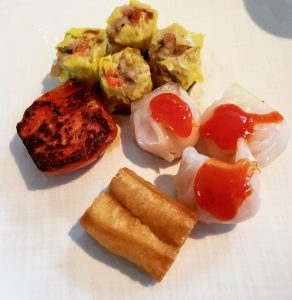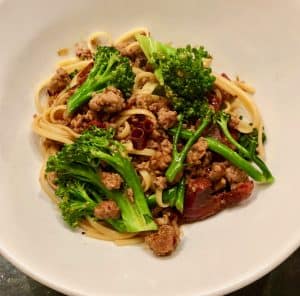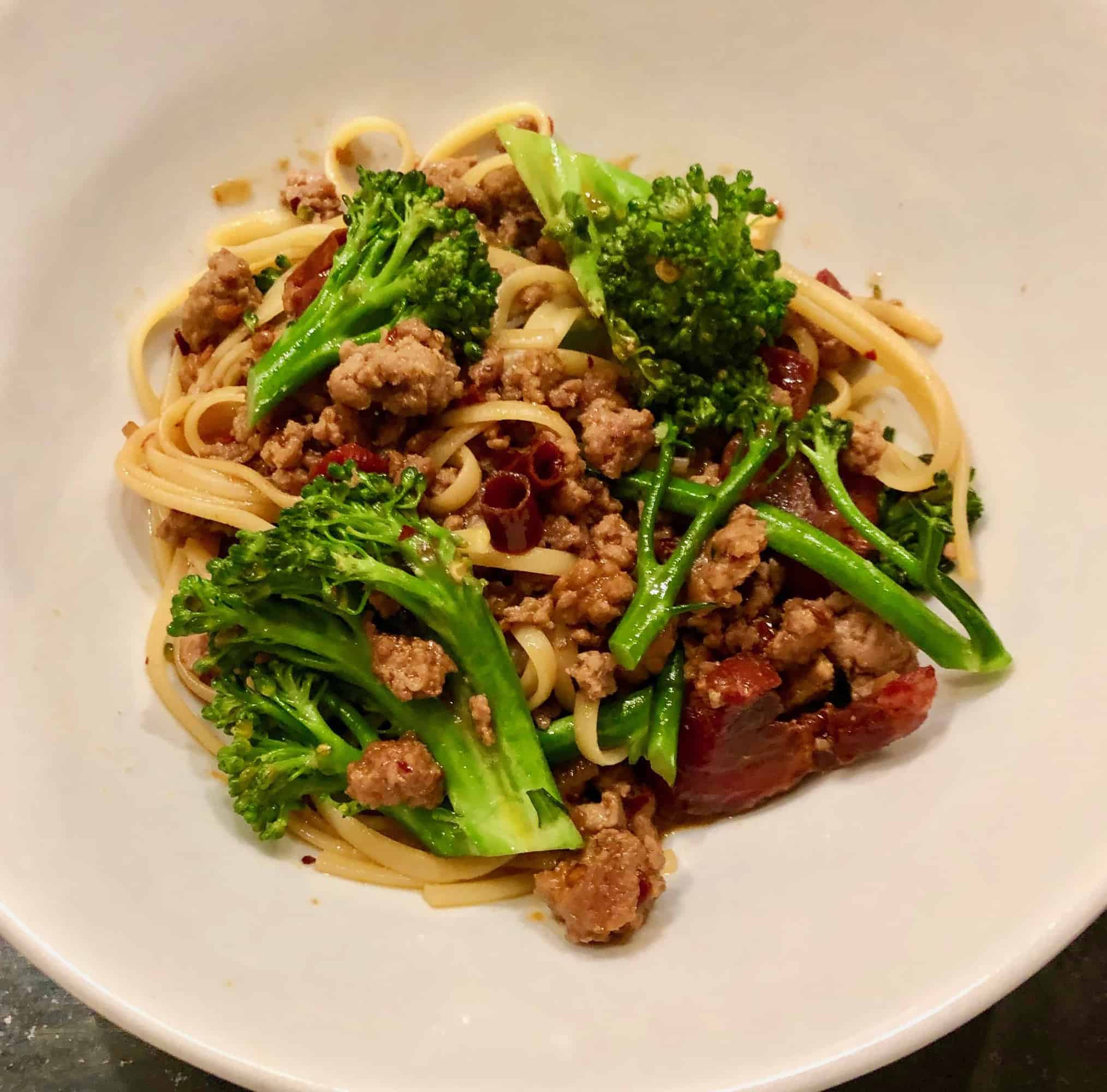Take a trip to Singapore tonight with this spicy, flavor-full dish that’s a one dish meal.

If you’ve never been to Singapore, you should put it near the top of your list. Before I went there last year, I am ashamed to say that only two things registered with me about Singapore. In 1994, a 19-year-old American named Michael Fay had been caned for vandalizing property there. The case became a cause célèbre that even then-President Bill Clinton weighed in on. (He was against it). The second Singapore memory came more recently. Our good friend Kathy had taken a job there. She told us of a law that made it illegal to be naked in your own home…if anyone else could see you. Armed with this knowledge, I vowed not to deface any property and to draw the shades whenever I was déshabillé.
Singapore is one of the best places in the world for superb “Street Food”

Singapore, I discovered, is a phenomenal Asian city filled with magnificent gardens, gleaming skyscrapers, fantastic hotels, wonderful food and so bent on the future, they’d almost destroyed what was left of the city’s Chinatown. It had almost been bull-dozed into oblivion. Even now, it is about a block long and completely surrounded by high rises. It was all in the name of public health and you have to hand it to Singapore: There’s probably nowhere in Asia where street food has become as sanitized as it is here. What was formerly a city filled with street food peddlers, Singapore started building markets for these Street food hawkers. These open- air food complexes are all over the city. They’ve even been moved indoors to air-conditioned food courts. I saw them in some of the city’s highest end shopping centers on Orchard Street, the city’s center for luxury shopping. After today’s recipe, I’ve attached a link to a terrific guide to the city’s best street foods and where you can find them.
Captured by the Shangri-La Hotel and its Horizon Club

I confess to having been a virtual prisoner to the incredible variety of food on offer all day long at the glorious Horizon Club atop the Shangri-La Hotel’s Tower wing. From breakfast on, a steady stream of food made its way to the buffets, steam tables, and hors d’oeuvres stations. It was magnificent and, as it was included in the room rate, irresistible. As were the open bar, the phenomenal city views and the concierge service that sent me off to unforgettable restaurants each evening. The most memorable of these is included in a link after the recipe. I was so impressed by what was on offer in Singapore that whenever I see a Singaporean recipe, I almost immediately want to cook it.
The recipe is filled with Asian flavors yet not at all hard to make.

Today’s recipe fell right into that category. It represents a pantry-full of Asian ingredients, a dizzyingly long list. Because I do love to cook Asian food, I happened to have it all on hand. I’d suggest that these should be staples in your pantry if you have any Asian cooking ambitions at all. Sooner or later, you will undoubtedly need them for pan-Asian cooking whether its Thai or Vietnamese or Chinese. I also confess to not being close enough to an Asian market to buy Chinese Broccoli. I opted for Broccolini. And despite my best efforts to shop the pantry first, I had to use Linguine for the noodles since my stock of Chinese egg noodles was not to be found. Finally, I relied on my local Chinese restaurant’s takeout for the Chinese Roast Pork. In all honesty, I am not sure it was really needed the roast pork at all. The ground pork had just the flavor this spicy, warming dish captures. It’s a wonderful taste of Singapore 9,521 miles away. Here is the recipe:
Singaporean Noodles with Two Porks
This traditional Singaporean dish is a savory mix of noodles, broccoli and pork two ways.

Ingredients
- 2 tablespoons canola oil
- 2 large shallots, finely chopped
- 2 garlic cloves, minced
- 1 pound ground pork
- 1 tablespoon light brown sugar
- 1 1/2 tablespoons Chinese black bean sauce
- 4 dried hot chiles
- 2 teaspoons Maggi sauce (a vegetable-based liquid seasoning) or soy sauce
- 2 teaspoons Asian fish sauce
- 1 1/4 cups low-sodium chicken broth
- 1 1/2 tablespoons unseasoned rice vinegar
- 2 tablespoons oyster sauce
- 1 teaspoon toasted sesame oil
- 1 tablespoon sambal oelek (hot chile sauce)
- 1 pound Chinese broccoli or Broccolini
- 1 pound fresh Chinese egg noodles, linguine or spaghetti
- 1/2 pound Chinese roast pork, thinly sliced
- 1 scallion, thinly sliced
Directions
- Step 1 In a very large nonstick skillet, heat 1 tablespoon of the canola oil. Add the shallots and garlic and stir-fry over moderately high heat until lightly browned, about 2 minutes. Add the ground pork, brown sugar, black bean sauce, dried chiles, Maggi sauce and fish sauce and cook, breaking up the meat with a spoon, until it is browned in spots, about 10 minutes. Add 3/4 cup of the chicken broth and cook over moderately low heat until the broth has evaporated, about 8 minutes. Stir in 1 tablespoon of the vinegar. Transfer the ground pork mixture to a bowl and wipe out the skillet.
- Step 2 In a jar, combine the remaining 1/2 cup of chicken broth and 1/2 tablespoon of vinegar with the oyster sauce, sesame oil and sambal oelek. Seal the jar and shake the sauce to blend.
- Step 3 Bring a large pot of water to a boil. Add the Chinese broccoli and cook until it is crisp-tender, about 2 minutes. Using tongs, transfer the broccoli to a work surface and cut it into 1-inch pieces. Return the water to a boil and add the noodles. Cook just until al dente. Drain the noodles, shaking off the excess water.
- Step 4 Heat the remaining 1 tablespoon of oil in the skillet. Add the roast pork, ground pork, broccoli and noodles and toss to combine. Add the sauce and cook, tossing, until the noodles are evenly coated, 5 minutes. Add the scallion, transfer to a large platter and serve.
Here’s a guide to Singapore’s Best Street Food courtesy of Eater.com
https://www.eater.com/2016/7/22/12241086/best-singapore-cheap-eats-street-food
Here are some other Singaporean Dishes on Chewing The Fat…
Singapore’s Signature Chili Crab may be easier to make Stateside than it is in Singapore.











